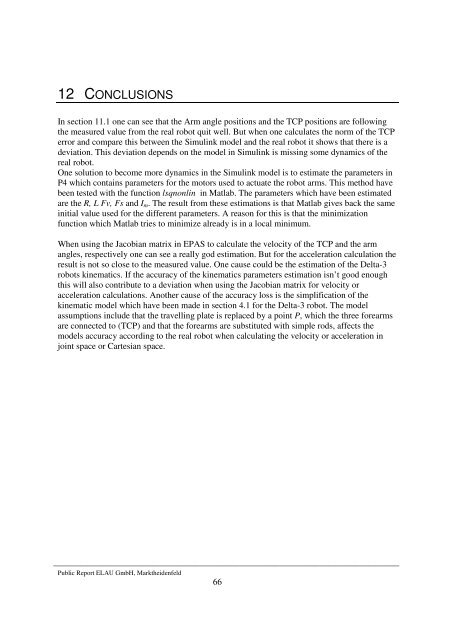Download full document - Automatic Control
Download full document - Automatic Control
Download full document - Automatic Control
You also want an ePaper? Increase the reach of your titles
YUMPU automatically turns print PDFs into web optimized ePapers that Google loves.
12 CONCLUSIONS<br />
In section 11.1 one can see that the Arm angle positions and the TCP positions are following<br />
the measured value from the real robot quit well. But when one calculates the norm of the TCP<br />
error and compare this between the Simulink model and the real robot it shows that there is a<br />
deviation. This deviation depends on the model in Simulink is missing some dynamics of the<br />
real robot.<br />
One solution to become more dynamics in the Simulink model is to estimate the parameters in<br />
P4 which contains parameters for the motors used to actuate the robot arms. This method have<br />
been tested with the function lsqnonlin in Matlab. The parameters which have been estimated<br />
are the R, L Fv, Fs and Im. The result from these estimations is that Matlab gives back the same<br />
initial value used for the different parameters. A reason for this is that the minimization<br />
function which Matlab tries to minimize already is in a local minimum.<br />
When using the Jacobian matrix in EPAS to calculate the velocity of the TCP and the arm<br />
angles, respectively one can see a really god estimation. But for the acceleration calculation the<br />
result is not so close to the measured value. One cause could be the estimation of the Delta-3<br />
robots kinematics. If the accuracy of the kinematics parameters estimation isn’t good enough<br />
this will also contribute to a deviation when using the Jacobian matrix for velocity or<br />
acceleration calculations. Another cause of the accuracy loss is the simplification of the<br />
kinematic model which have been made in section 4.1 for the Delta-3 robot. The model<br />
assumptions include that the travelling plate is replaced by a point P, which the three forearms<br />
are connected to (TCP) and that the forearms are substituted with simple rods, affects the<br />
models accuracy according to the real robot when calculating the velocity or acceleration in<br />
joint space or Cartesian space.<br />
______________________________________________________________________________<br />
Public Report ELAU GmbH, Marktheidenfeld<br />
66














